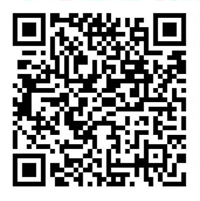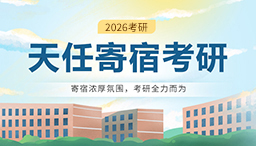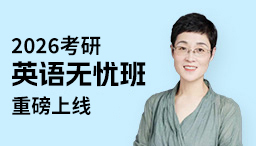(科目代码:204)
1. 答题前,考生须在试题册指定位置上填写考生编号和考生姓名;在答题卡指定位置上填写报考单位、考生姓名和考生编号,并涂写考生编号信息点。
2. 选择题的答案必须涂写在答题卡相应题号的选项上,非选择题的答案必须书写在答题纸指定位置的边框区域内,写在其它地方无效。
3. 填(书)写部分必须使用黑色字迹签字笔或钢笔书写,涂写部分必须使用2B铅笔填涂。
4. 考试结束,将答题卡和试题册一并装入试题袋中交回。
Section Ⅰ Use of English
Directions: Read the following text. Choose the best word(s) for each numbered blank and mark A, B, C or D on the ANSWER SHEET. (10 points)Many in the profession are worried that too few women work in economics at senior level. But ___1___ recently has the source of much of the problem been identified: women are far less ___2___ than men to study economics, ___3___ pursue a career in it. Just over a third of undergraduate economics students in the UK are women. The picture is ___4___ in Australia and the US.
Osama Rahman, who jointly ___5___ a team trying to boost the number of women among the ranks of UK civil service economists. Her initial thinking was that for some reason female economists were ___6___ there but not applying to the Government Economic Service. It was only later that she realized there was a problem with women not ___7___ to study economics. The subject was once at the forefront of women’s educational liberation. The first coeducational university lecture in the UK was ___8___ by a professor of political economy at University College London in 1871. ___9___ other traditionally male subjects such as engineering have made progress in attracting women, economics has struggled.
One explanation frequently ___10___ for why so few women study economics is ___11___ the mathematical nature of the subject puts them ___12___. This does not stand up to ___13___, as the share of women among maths undergraduates ___14___ that in economics. But economics does have an image problem. Kawthar Msrar at St Marylebone school said that economics is ___15___ seen as a very male-oriented job; there is not a widespread ___16___ yet that girls can do it, too. Her classmate Bryony Jones agrees that as a mixed race woman, she doesn’t see anyone who looks like her doing economics.
In the UK, economics graduates ___17___ second — behind graduates in medicine — in ___18___ earnings, according to data from the Institute for Fiscal Studies. Female economics graduates earned on average 20,000 pounds more a year a decade after ___19___ than creative arts graduates. But typically, women place less ___20___ than men on financial return when choosing which subject to study.
| 1. A. not | B. hardly | C. only | D. even |
| 2. A. possibly | B. likely | C. potential | D. probable |
| 3. A. let alone | B. as a result | C. in a word | D. above all |
| 4. A. contrary | B. equal | C. balanced | D. similar |
| 5. A. leads | B. directs | C. governs | D. influences |
| 6. A. around | B. off | C. out | D. towards |
| 7. A. responding | B. converting | C. disposing | D. choosing |
| 8. A. accepted | B. conducted | C. addressed | D. advanced |
| 9. A. While | B. When | C. Once | D. Since |
| 10. A. denied | B. evaded | C. valued | D. given |
| 11. A. as | B. because | C. that | D. how |
| 12. A. away | B. off | C. on | D. up |
| 13. A. requirements | B. observation | C. reality | D. scrutiny |
| 14. A. proceeds | B. exceeds | C. excludes | D. prompts |
| 15. A. also | B. again | C. still | D. instead |
| 16. A. realization | B. information | C. condition | D. convention |
| 17. A. arrange | B. rank | C. obtain | D. occupy |
| 18. A. basic | B. common | C. average | D. maximum |
| 19. A. graduation | B. work | C. research | D. analysis |
| 20. A. effort | B. time | C. energy | D. weight |
Section Ⅱ Reading Comprehension
Part A
Directions: Read the following four texts. Answer the questions below each text by choosing A, B, C or D. Mark your answers on the ANSWER SHEET. (40 points)Denmark is once again distinguishing itself in the race against food waste — this time, with a supermarket hawking items once destined for the trash bin. Those items might include treats for a holiday that happened last week, a ripped box of cornflakes, plain white rice mislabeled as basmati, or anything nearing its expiration date. In other words, perfectly edible items that are nonetheless considered unfit for sale by the retailers and manufacturers who donate them.
WeFood is not the first grocer in Europe to sell surplus food. But unlike so-called “social supermarkets” — stores that serve almost exclusively low-income people — WeFood’s offerings are very intentionally aimed at the general public. High-income families will also choose WeFood for its environmental-friendly conception. The store’s goods are priced 30 to 50 percent lower than those in regular supermarkets, according to WeFood. The store has already been a huge success, attracting large numbers of customers. People have lined up before the store’s opening every morning since its launch on Monday.
But is this food safe to eat? Safety is always the first concern coming up to your mind. Well, the “sell by” date you see on many products actually refers to its freshness-not whether or not it’s going to do you any harm. In many cases, food that's beyond this date won’t be as fresh as it once was but is still perfectly edible. The food might have not yet gone bad when the “sell by” date expires. Of course you should still be careful to avoid eating food that's gone off, but you might find you don’t have to throw away as much as you think you do.
Denmark throws away about 700,000 tons of food every year, according to several estimates. In fact, food waste is a major problem for the whole world. Some 795 million people are undernourished globally, according to the World Food Program. Yet about a third of all food produced in the world — some 1.3 billion tons — is wasted each year, according to the United Nations. The cost of global food wastage is about $1 trillion a year. All of the store’s proceeds will go to DanChurchAid’s work in developing nations like South Sudan and Bangladesh.
21. It can be learned from Paragraph 1 that a supermarket in Denmark ________.
[A] recycles the wasted food in supermarket
[B] runs a campaign against food waste
[C] donates food to retailers and manufacturers
[D] reuses mislabeled food in supermarket
22. WeFood is a supermarket which ________.
[A] only attracts low-income people
[B] is the first retailer of surplus food
[C] sells low-price food and products
[D] draws little attention from the public
23. The “sell by” date on the merchandise indicates that ________.
[A] it is not fresh beyond this date
[B] people should throw it away immediately
[C] it’s illegal to sell it in regular supermarkets
[D] expired food is definitely safe to eat
24. We can learn from the World Food Program that ________.
[A] people should donate food to developing countries
[B] we should avoid dumping surplus food
[C] more WeFood grocers are needed to help the poor
[D] about one tenth of the population in the world are malnourished
25. Which of the following would be the most appropriate title of the text?
[A] Save the Food, Save the World
[B] A New Way to Save Food and Money in Denmark
[C] A Denmark Market Selling Expired Food to Combat Waste Problems
[D] People Line up for Expired Food in Denmark
When education fails to keep pace with technology, the result is inequality. Without the skills to stay useful as innovations arrive, workers suffer — and if enough of them fall behind, society starts to fall apart. That fundamental insight seized reformers in the Industrial Revolution, heralding state-funded universal schooling. Later, automation in factories and offices called forth a surge in college graduates. The combination of education and innovation, spread over decades, led to a remarkable flowering of prosperity.
Today robotics and artificial intelligence call for another education revolution. This time, however, working lives are so lengthy and so fast-changing that simply cramming more schooling in at the start is not enough. People must also be able to acquire new skills throughout their careers.
Unfortunately, as our special report in this issue sets out, the lifelong learning that exists today mainly benefits high achievers — and is therefore more likely to exacerbate inequality than diminish it. If 21st-century economies are not to create a massive underclass, policymakers urgently need to work out how to help all their citizens learn while they earn. So far, their ambition has fallen pitifully short.
The classic model of education — a burst at the start and top-ups through company training—is breaking down. One reason is the need for new, and constantly updated, skills. Manufacturing increasingly calls for brain work rather than metal-bashing. The share of the American workforce employed in routine office jobs declined from 25.5% to 21% between 1996 and 2015. The single, stable career has gone the way of the Rolodex.
Pushing people into ever-higher levels of formal education at the start of their lives is not the way to cope. Just 16% of Americans think that a four year college degree prepares students very well for a good job. Although a vocational education promises that vital first hire, those with specialized training tend to withdraw from the labour force earlier than those with general education — perhaps because they are less adaptable.
At the same time on-the-job training is shrinking. In America and Britain it has fallen by roughly half in the past two decades. Self-employment is spreading, leaving more people to take responsibility for their own skills. Taking time out later in life to pursue a formal qualification is an option, but it costs money and most colleges are geared towards youngsters.
26.The society fails to work correctly if_______.
[A] education falls behind technological development
[B] plentiful workers lack useful skills
[C] workers are not innovative enough
[D] workers suffer from unequal treatment
27. The new education revolution makes a request that people should_______.
[A] prolong their working life
[B] stay in one permanent position
[C] shorten their working life
[D] keep lifelong learning
28. Who gains most from the existing lifelong learning system?
[A] Successful men. [B] Decision makers.
[C] Massive underclass. [D] Common citizens.
29. The word “metal-bashing” (Para. 4) most probably means_______.
[A] piece-work [B] mental job
[C] physical labor [D] intellectual work
30. It is unlikely to acquire formal qualification later in life because_______.
[A] self-employment is the mainstream
[B] it’s costly and eligible for certain people
[C] we have to shoulder duties for our skills
[D] formal qualification doesn’t mean good job
Dating is a unpredictable business. There may be plenty of fish in the sea, yet many are self-absorbed or attached to ex-fish. Digital dating sites, including a growing array of matchmaking apps, are meant to help. Their design owes more to practical economics than it does to the mysteries of the heart.
In a sense, searching for a mate is not so different from hunting for a job. Jobs, like prospective partners, have their strengths and weaknesses, which makes finding the right one a matter of complicated trade-offs. The exchanges between matches are different from other transactions, in that either of the party must be enthusiastic about the match for it to happen. A supermarket, in contrast, does not particularly care whose wallet it is draining, nor does the power company agonize about whether a customer is worthy of its watts.
Alvin Roth, who won a Nobel prize jointly with Lloyd Shapley in 2012, found that the structure of matching markets made a significant difference in determining who got together with whom. Systems designed to elicit people’s true preferences generated better matches between hospitals and doctors, for example. But the entire medical profession has an interest in improving matches, and so can set up a national clearing house to do just that. The lovelorn must instead rely on an array of digital matchmakers.
Good matches depend on good information. Even without digital help, people usually have some inkling of how much they have in common. Cosmopolitan strivers move to New York, for example, rather than sleepier cities, in part because they will meet other ambitious types with similar interests. Within New York, the places people choose to spend their time — whether Yankee Stadium or a yoga studio — determine which sorts of people they come into contact with. Because it is expensive to live in New York, and to spend time sweating in a yoga studio or swearing in the stands, people in such settings can be reasonably confident that those around them are in some sense like-minded.
But one critical bit of information is missing: whether there is mutual interest. The act of asking someone out is fraught. In the non-digital world, approaching a potential partner brings the risk of awkwardness. Digital dating reduces this cost dramatically. Apps like Tinder and Happn, for example, reveal that a user likes another only when the feeling is mutual.
31.According to paragraph 1, digital dating sites’ design .
[A]is based on the economic principles supporting the match
[B]employs more practical ways to tackle the dating problems
[C]should mainly conform to people’s psychological needs
[D]is novel enough to attract some potential customers
32.Matching exchanges differs from other deals because .
[A]the transactions will encounter realistic obstacle
[B]a wonderful match depends on two sides
[C]this kind of pairing happens occasionally
[D]searching for a mate is beyond imagination
33.The example of the matches between hospitals and doctors is mentioned to show that .
[A]better matches are associated with the shared information
[B]difference between the matches affects people’s true preferences
[C]the message conveyed by the medical profession is intriguing
[D]the matches are determined by the systems of the markets
34.According to Para. 4, people who exercise in a yoga studio .
[A]entertain interesting notions
[B]are comparatively sensible
[C]may have interests in common
[D]assume an positive attitude
35.The author’s attitude towards digital dating is .
[A]indifferent [B]questionable [C]contemptuous [D]positive
As Samuel Goldwyn so widely counseled, never make predictions — especially about the prospect. But here is one: The analogy between 20th-century physics and 21st-century biology will continue, for both good and ill.
Physics gave two things to the 20th century. The most conspicuous gift was power over nature. That power was not always benign, as the atomic bomb showed. Physics also bestowed the 20th century a more subtle boon than mere power. It also brought an understanding of the vastness of the universe and humanity’s insignificant place in it. But if the 20th century was distinguished by anything from its predecessors, that distinctive feature was physical technology, from motor cars and airplanes to computers and the internet.
It is too early to be sure if the distinguishing feature of the 21st century will be biological technology, but there is a good chance that it will be. Simple genetic engineering is now routine; indeed, the first patent application for an artificial living organism has recently been filed. Both the idea of such an organism and the idea that someone might own the rights to it would have been science fiction even a decade ago. And it is not merely that such things are now possible.
The other driving force of technological change—necessity—is also there. Many of the big problems facing humanity are biological, or are susceptible to biological intervention. The question of how to deal with an aging population is one example. Climate change, too, is intimately bound up with biology since it is the result of carbon dioxide going into the air faster than plants can remove it. And the risk of a new, lethal infection suddenly becoming pandemic as a result of modern transport links is as biological as it gets. Even the fact that such an infection might itself be the result of synthetic biology only emphasizes the biological nature of future risks.
At the moment, policymakers have inadequate technological tools to deal with these questions. But it is not hard to imagine such tools. Aging is directly biological. It probably cannot be stopped, but knowing how cells work—really knowing—will allow the process to be transformed for the better. At least part of the answer to climate change is fuel that grows, rather than fuel that is dug up. Only biotechnology can create that. And infections, pandemic or otherwise, are best dealt with by vaccines, which take a long time to develop. If cells were truly understood, that process might speed up to the point where the vaccine was ready in time to do something useful.
36. The word “benign” (Para.2) most probably means_______.
[A] detrimental [B] beneficial
[C] powerful [D] frightening
37. According to the author, what distinguishes the 21st century from the 20th century?
[A] Biological technology. [B] Physical technology.
[C] Computers and the internet. [D] Modern transport links.
38. According to the author, biological technology in the 21st century will_______.
[A] speed up the aging population
[B] aggravate the climate change
[C] keep new fatal infections in check
[D] understand the vast universe
39. It can be inferred from the ending paragraph that_______.
[A] biotechnology will find fuel that is dug up from underground
[B] understanding of cells succeeded in preventing humans from aging
[C] the vaccines have been developed to curb pandemic infections
[D] there still lacks due technology to handle climate change
40. What is the author’ attitude towards the 21st century?
[A] indulgent.
[B] Optimistic.
[C] confused.
[D] Skeptical.
Part B
Directions: Read the following text and answer the questions by choosing the most suitable subtitle from the list A-G for each of the numbered paragraphs (41-45). There are two extra subtitles which you do not need to use. Mark your answers on the ANSWER SHEET. (10 points)In recent days, American Airlines has been forced to cancel more than 40 flights in Phoenix. The reason: With daytime highs hovering around 120 degrees, it was simply too hot for some smaller jets to take off. Hotter air is thinner air, which makes it more difficult—and sometimes impossible—for planes to generate enough lift. As the global climate changes, disruptions like these are likely to become more frequent, researchers say, potentially making air travel costlier and less predictable with a greater risk of injury to travelers from increased turbulence.
“We tend to ignore the atmosphere and just think that the plane is flying through empty space, but of course, it' s not,” said Paul D. Williams, a professor in the Department of Meteorology at the University of Reading in Britain. “Airplanes do not fly through a vacuum. The atmosphere is being modified by climate change.” The problem in Phoenix primarily affected smaller jets operated by American’s regional partner airlines.
“When you get in excess of 118 or higher, you ' re not able to take off or land,” said Ross Feinstein, a spokesman for American Airlines, referring to the smaller aircraft. Bigger jets like Boeing 737s and Airbus A320s have higher operating thresholds (126 and 127 degrees, respectively), he said. But even though bigger planes weren’t affected, he added, American decided to give passengers on any flight to or from Phoenix the option to change their trips.
Overall, that means more than 350 flights were potentially affected by the hot weather in Phoenix. Robert Mann, the president of airline industry analysis firm R.W. Mann & Co., said that although airlines were working to become more efficient now, they were not doing much to prepare for the longer-term effects of climate change. “In a world where they're focused on near-term issues, the glacial rate of environmental change is not within their fleet-planning horizon,” he said.
Researchers are just beginning to explore how climate change affects aviation and planes’ ability to fly. Because there is so little data available and so many factors at play—aircraft design, airport size and location, the weight of passengers and cargo, to name just a few—it can be hard to attribute any one service disruption to global warming.
Depending on their locations, airports may experience the effects differently. La Guardia has a short runway relative to other major commercial airports, and on particularly hot days that can be a problem: Planes might not have enough distance to achieve the speed and lift needed to get airborne. “Typically in the hotter days of the summer, you may have to bump payload, which includes cargo and/or passengers,” said David Wilhelm, a senior dispatch manager at Southwest Airlines. Reducing weight allows a plane to take off with less lift.
As global temperatures continue to rise, some of the heaviest planes on the longest flights may eventually be unable to depart during the hottest part of summer days, Radley Horton said, a research scientist at Columbia University’s Earth Institute. He also pointed out that a no-fly window of even a few hours at a particular airport could have a chain effect across airline operations.
With forecasts predicting record-breaking temperatures in Phoenix on Tuesday—and some flights being canceled preemptively—many passengers stayed away from the airport entirely.
| [Al figures out that all the airlines are advancing preparation for climate change. | |
| 41. Paul D. Williams | [B] holds the view that airlines don’t put more emphasis on longer-term issues of climate change. |
| 42. Ross Feinstein | [C] believes that decreasing payload of cargo or passengers can make airplane take off. |
| 43. Robert Mann | [D] says that downplaying the importance of atmosphere is not right. |
| 44. David Wilhelm | [E] points out that global warming is not the only reason for airline service disruption. |
| 45. Radley Horton | [F] thinks that the smaller airplane cannot operate over 118 degrees. |
| [G] considers that the plane was grounded for hours, which has a knock-on effect on airline operations. |
Section Ⅲ Translation
Directions: In this section there is a text in English. Translate it into Chinese, write your translation on ANSWER SHEET 2. (15 points)
We experience a burst of pleasure when we share our thoughts, and this drives us to communicate. It is a useful feature of our brain, because it ensures that knowledge, experience and ideas do not get buried with the person who first had them, and that as a society we benefit from the products of many minds.
Of course, in order for that to happen, merely sharing is not enough. We need to cause a reaction. Each time we share our opinions and knowledge, it is with the intention of having an impact on others. Here' s the problem, though: we approach this task from inside our own heads. When attempting to create impact, we reflect on what is persuasive to us, our state of mind, our desires and our goals. But if we want to affect the behaviors and beliefs of the person in front of us, we need to understand what goes on inside their head.
Section Ⅳ Writing
Part A
47. Directions:Suppose your friend Li Ming won a computer technology competition. Write him/her a letter to
1) congratulate him/her, and
2) invite him/her to share experience for freshmen.
You should write about 100 words on ANSWER SHETE.
Do not sign your own name at the end of the letter. Use “Zhang Wei” instead.
Do not write the address. (10 points)
Part B
48. Directions:Write an essay based on the chart below. In your writing , you should
1) interpret the chart, and
2) give your comments
You should write about 150 words on the ANSWER SHEET. (15 points)















